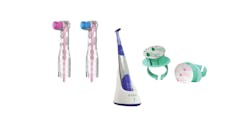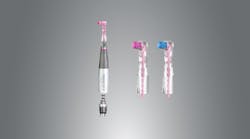Chairside Impact: Elevating the standard of spatter prevention post-COVID
Dental hygiene has always been one of the most hazardous professions due to continuous exposure to radiation, chemicals, ergonomic strain, pathogenic spatter, and aerosols. Even though this is common knowledge, it took a viral pandemic sweeping the world nearly four years ago to remind us of the daily dangers that clinicians face in the op and the need for increased precautionary measures to prevent the spread of disease.
Multiple components of a hygiene visit pose concerns for the clinician, but coronal polishing sits near the top of the list. In a typical day, nearly all hygiene patients undergo polishing. This procedure generates a significant amount of spatter—liquid particles greater than 100 microns filled with saliva, blood, microorganisms, and polishing material that settle quickly on nearby surfaces after being projected from their source.1 Spatter can be seen with the naked eye and often lands on the clinician’s hair, face, hands, scrubs, and operatory equipment. Barriers and PPE can shield the provider from these contaminants, but PacDent has developed products that prevent spatter at the source.
ProPaste One Ring and Paste Combo
Aside from things like particle grit and flavor that impact the patient experience, viscosity—the thickness, resistance, or stickiness of a fluid—is a characteristic of prophy paste that is often overlooked during the selection process. The ProPaste One combo was specifically designed with this in mind. Individually preassembled in a single-use, adjustable ring, the AntiSplatr paste has the perfect viscosity that allows for easy use while preventing spatter. Available in a variety of flavors and grit options, patients will also reap the desensitizing and remineralizing benefits of sodium fluoride and tricalcium phosphate with each polishing procedure.
AntiSplatr Disposable Prophy Angle
It can feel a bit overwhelming choosing a type of prophy angle with the expansive selection that is currently available. If reducing spatter is desired, the options become much narrower. PacDent’s AntiSplatr prophy angle is uniquely designed with a discreet, flexible fender that catches polish and fluids that accumulate around the cup. This simple, cutting-edge feature prevents spatter by nearly 100% while providing the operator with a clear view and easy maneuverability. Clinicians also enjoy the thin, adaptable cup lip that allows for easy subgingival access and the ability to polish tight contacts.
ProMate CL Cordless Hygiene Handpiece
One last consideration in improving infection control measures during polishing is making the switch to a cordless handpiece. In addition to the ergonomic benefits associated with using a lighter system with no cord drag, the ProMate CL offers enhanced maneuverability, which allows the operator to angle the equipment in a way that maintains consistent contact with their working area, thereby preventing spatter and minimizing overall exposure time. This handpiece includes multiple protective sheaths that can be changed and sterilized between patients, reducing the risk of cross-contamination and the spread of infection.
Traditional dental hygiene procedures have been challenged by recent public health events. Our mentality in infection prevention has shifted from defense to offense, aiming to stop pathogens from spreading at the source. It is our professional responsibility to select tools and techniques that will deliver the intended results most safely. In a post-COVID operatory, PacDent’s AntiSplatr polishing solutions represent the next level in patient care.
Editor's note: This article appeared in the March 2024 print edition of RDH magazine. Dental hygienists in North America are eligible for a complimentary print subscription. Sign up here.
Reference
- Noordien N, Mulder-van Staden S, Mulder R. In vivo study of aerosol, droplets and splatter reduction in dentistry. [Published correction appears in 2023;15(8):1669]. Viruses. 2021;13(10):1928. doi:10.3390/v13101928
Bethany Montoya, BAS, RDH, is a practicing dental hygienist, editorial director of DentistryIQ's Clinical Insights newsletter, and a key opinion leader. She has advanced knowledge and training in complex cosmetic dentistry, dental sleep medicine, and implant dentistry. Recently, she has devoted her time to dentistry’s personal and interpersonal aspects through her social media brand, @humanrdh. Contact Bethany at [email protected].









